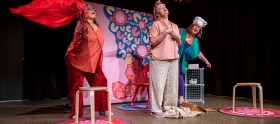Image via Shutterstock.
‘Have no fear of perfection, you’ll never reach it,’ said Salvador Dali. This is easier said than done for many.
As logical as this advice may sound in theory, the battle with perfectionism is a very real one for many creatives, and although some degree perfectionism can be healthy, there is a danger that this psychological construct can spell the end of your career.
Chris Stevens is a Sydney-based psychologist who has worked with groups and individuals across the arts sector in addition to running programs on creative wellness. Stevens said there are two types of perfectionism we should be aware of in order for us to evaluate our own behaviours.
‘If someone has perfectionistic strivings they have high-levels of intrinsic motivation and they love what they’re doing,’ Stevens said. ‘These people tend to have lower levels of self-criticism and higher self-esteem and they’re moving towards perfection, rather than having to be perfect.’
Then there’s the dark side.
‘Perfectionistic concerns are quite different; they tend to be driven more by fear rather than curiosity; there’s a lot of self-consciousness and self-concern.
‘People who have perfectionistic concerns will be self-critical no matter how often they encounter success, because what lies underneath is usually an unexamined fear that the person feels inadequate in some form,’ he noted.
How much of a perfectionist you are is also linked to whether you have a fixed or a growth mindset.
‘A person with a fixed mindset believes their attributes are permanent and may think: “Intelligence is something I can’t change; talents are something I can’t change.”’
Stevens says it’s not surprising then that these people often fall into the category of those who have perfectionistic concerns while those with growth mindsets believe behaviours can be changed and tend to have perfectionistic strivings.
‘The good thing about this mindset stuff is that it appears to be learned rather than innate and I lean towards the camp who say that perfectionism is probably largely environmental which means you can do things about it.’
1. STOP BEING PRECIOUS
Gretchen Miller, an internationally-awarded program maker for the ABC who has 20 years experience, has witnessed the harm perfectionism can cause.
‘In my career, I’ve seen a lot of perfectionists fall by the wayside thinking their work isn’t “ready” for publication, that it’s not good enough,’ Miller said.
‘This can be a form of narcissism in a sense – that “I’m better than this – I can’t reveal my genius just yet, it isn’t polished enough to demonstrate all the facets of brilliance I know I have!!”‘
The advice Miller gives may not be palatable to some, but it comes from a place of truth.
‘What I would say to those people is: Actually, no-one really cares that much about you and your work, they’re too busy thinking about themselves.
‘You spend years being coy, and suddenly you’re left behind. So just put it out there and get on with the next piece.’
2. KEEP PRODUCING – SEEK FEEDBACK
Like Miller, Stevens agrees that hanging onto work for fear of imperfection is a road block. His suggestion is to produce as much work as you can and seek continuous feedback during the process.
‘If you’re only producing work that you think demonstrates your ability, you’ll be denying yourself the opportunity for feedback,’ Stevens said.
‘What you have to practice is showing work early and frequently and find people whose opinion you trust.’
Adey is a freelance production and theatre artist at House of Vnholy who believes consistent feedback from peers can be beneficial to perfectionists.
‘I am often on my own and this solitude sometimes can create a vicious circle of self-doubt which then breeds the need for perfection before you present an idea/concept/work to an audience,’ he said.
‘I’ve found within my practice that my best critics are the peers close to me – my partner for example. I consult with them for an honest critique; this doesn’t always go down so well, but with age I have adapted to accept critical feedback, and intuitively bundle the feedback that works for me and my anxiety and/or ego.’
3. SET DEADLINES
‘Getting out of isolation, showing work regularly to others and making promises and commitments is a very important way to push us past this individual preciousness,’ Stevens says of perfectionism.
‘In the 20 and 21st century, this idea of the solo artist; writing alone, or making music – painting – that’a a relatively new phenomenon. It doesn’t feed well into the importance of a bit of social pressure like: Oh fuck, I actually have to produce this by next week.’
Novelist Anna Westbrook agrees and suggests locking in regular meetings with like-minded individuals as a motivator to get things done.
‘I would say the most fruitful thing to do is forming your own support groups – other creatives pursuing similar projects where you meet monthly and you actually get motivated by fear of letting those people down,’ she told ArtsHub.
4. LEARN TO LET GO
‘There has been a point to where my perfectionism, especially in delivering a design for theatre projects, has physically had a negative impact on my own health where I’m putting myself in a situation where heavy or hard labour or long hours have been required to make a deadline,’ Adey observes.
He admits that learning to relinquish control is an important part of taming perfectionistic traits.
‘If we truly want to succeed in an arts career, we need to be open-minded and willing to let go of what we can’t control and let things evolve in their own time – a sort of meditation and catharsis can come of this.’
Stevens agrees. ‘You have to be able to be aware of what you’re experiencing in the moment and if you’re not being productive, let it go.’
‘So when the anxiety comes up you can say, “No this is part of the process; this is just fixed mindset stuff or it’s just perfectionism. It doesn’t actually mean anything,”’ he said.
5. EMBRACE YOUR IMPERFECTIONS
Dr Ryan Jefferies is the Head of Programs at the Science Gallery and is currently working with a curatorial advisory panel of academics and artists on PERFECTION, an exhibition which explores subjectivity versus objectivity and will question our relationship with imperfection, diversity and error.
Jefferies said: ‘Perfectionism in artist practice can stifle the creative process – leading to less innovation and willingness to push boundaries.
‘Science Gallery promotes experimental practice among artists and scientists to produce inter-disciplinary artworks that are not polished or over-developed. Our focus is on the concept or idea of a work and the conversation that this sparks. And if this means the final work is a little rough around the edges, than that is okay.’
Miller also shares Jefferies’ sentiments. ‘I recently finished a four part series that was a big co-production with the BBC World Service. It was the last series of my 20 year career at the ABC and I’ve now left to go freelance,’ she said.
‘I was very proud of it and I listened back a few months later, and heard all sorts of things I didn’t like much and would fix if I had the opportunity/could be bothered. But you know what? It is what it is. It’s a product of a moment of time. If we’d had longer etc. would it be any better? In the end I just shrug and think – well, it was “good enough” for the BBC and the ABC. It told a story. There were some strong moments. I’m just happy to move on and think about the next gig!’






